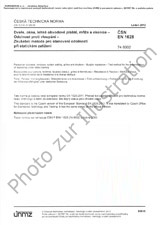Wir benötigen Ihre Einwilligung zur Verwendung der einzelnen Daten, damit Sie unter anderem Informationen zu Ihren Interessen einsehen können. Klicken Sie auf "OK", um Ihre Zustimmung zu erteilen.
ČSN ETSI EN 302537-V2.1.1 (875140)
Ultra Low Power Medical Data Service (MEDS) Systems operating in the frequency range 401 MHz to 402 MHz and 405 MHz to 406 MHz; Harmonised Standard covering the essential requirements of article 3.2 of the Directive 2014/53/EU
Name übersetzen
NORM herausgegeben am 1.3.2017
Informationen über die Norm:
Bezeichnung normen: ČSN ETSI EN 302537-V2.1.1
Zeichen: 875140
Katalog-Nummer: 501555
Ausgabedatum normen: 1.3.2017
SKU: NS-676739
Zahl der Seiten: 60
Gewicht ca.: 180 g (0.40 Pfund)
Land: Tschechische technische Norm
Kategorie: Technische Normen ČSN
Kategorie - ähnliche Normen:
Die Annotation des Normtextes ČSN ETSI EN 302537-V2.1.1 (875140):
V2.1.1
The present document applies to ultra low power systems and accessories operating in spectrum within the bands 401 MHz to 402 MHz and 405 MHz to 406 MHz that operate in a MEDS service for telecommand and telemetry between devices that are part of a MEDS (see definition of MEDS);
1) Only two types of MEDS system devices are permitted under the present document:
- 2) Frequency agile devices designed to access a minimum of 18 channels evenly distributed across the 401 MHz to 402 MHz and 405 MHz to 406 MHz bands with a minimum of 9 channels for each 1 MHz segment (i.e. 401 MHz to 402 MHz and 405 MHz to 406 MHz).
Devices capable of operation only on a single channel using low duty cycle and low power for spectrum access in the 401 MHz to 402 MHz or 405 MHz to 406 MHz bands, see clause 4.2.3.1.2 and the following clauses.
The frequency usage conditions for the bands 401 MHz to 402 MHz and 405 MHz to 406 MHz are European wide harmonised for "active medical implant devices" according to Commission Implementing Decision 2013/752/EU [i.12] and ERC Decision (01)17 [i.1] with the following usage restrictions:
- " "This set of usage conditions is only available for systems specifically designed for the purpose of providing non-voice digital communications between active implantable medical devices and/or body-worn devices and other devices external to the human body used for transferring non-time critical individual patient-related physiological information."
The present document covers devices utilizing ultra low power radio devices in combination with medical devices, the medical portion of which is regulated by the Medical Device Directive [i.8] (MDD) or the Active Implantable Medical Device Directive (AIMD [i.9]). The radio part of medical devices regulated by the MDD is hereafter referred to as ULP-AMD, ULP-AMD-P for peripheral devices, and ULP-BWD for body worn devices. ULP-BWD are devices, such as a physiological parameter sensor or handheld devices that are intended to operate in very close proximity to the human body, including touching the body, whose radio antenna is external to the body and is used to communicate with a device that is part of a MEDS system. The radio part of medical devices regulated under the AIMD is hereafter referred to as Ultra Low Power-Active Medical Implants (ULP-AMI) and peripherals (ULP-AMI-P) used in a Medical Data Service (MEDS).
Devices covered by the present document are an evolving new technology to be made available worldwide by the medical equipment industry that will provide high speed communications capability between devices associated with an individual patient that are part of a complete MEDS system as defined in clause 3.1. Examples of MEDS devices falling under the scope of the present document are portable body worn physiological sensors that allow ambulatory monitoring, implanted devices and external system devices used to transfer data collected by a MEDS system to medical practitioners that will use the data to diagnose and treat a patient.
The present document contains requirements to demonstrate that Ultra Low Power Medical Data Service (MEDS) Systems operating in the frequency range 401 MHz to 402 MHz and 405 MHz to 406 MHz ". shall be so constructed that they both effectively use and support the efficient use of radio spectrum in order to avoid harmful interference" (article 3.2 of the Directive 2014/53/EU [i.2]). It does not necessarily include all the characteristics, which may be required by a user, nor does it necessarily represent the optimum performance achievable
Normansicht ČSN ETSI EN 302537-V2.1.1 (875140)
Empfehlungen:
Aktualisierung der technischen Normen
Wollen Sie sich sicher sein, dass Sie nur die gültigen technischen Normen verwenden?
Wir bieten Ihnen eine Lösung, die Ihnen eine Monatsübersicht über die Aktualität der von Ihnen angewandten Normen sicher stellt.
Brauchen Sie mehr Informationen? Sehen Sie sich diese Seite an.




 Cookies
Cookies
